In 2023, the Philippines welcomed over 5 million visitors, confirming its status as a top spot for those seeking a tropical getaway in Southeast Asia. With more than 7,600 islands, the country offers a wealth of attractions, including beautiful beaches, natural wonders, cultural heritage, casinos, and even malls! But with so many islands to explore, planning your trip can be daunting. In this comprehensive guide, we’ll provide you with information on the best places to visit, fun activities to do, where to stay, local food to try, and tips for traveling around safely and affordably, to help you build your itinerary.
Table of Contents
- Best Places to Visit in the Philippines
- Accommodation: Where to Stay
- Transportation: Getting Around the Philippines
- Must-Try Filipino Foods
- Best Things to Buy in the Philippines
- When to Visit the Philippines
- Travel Tips and Reminders
Best Places to Visit in the Philippines
The Philippines comprises 82 provinces scattered across its islands, making travel between them a bit tricky, especially for those from abroad. To plan your trip smoothly, it’s best to figure out which provinces you want to visit first. This will help you choose the right airport for your arrival and local travel.
The Philippines has eleven international airports and 33 domestic principal airports.
Civil Aviation Authority of the Philippines
For newcomers, we recommend starting with these six touristy spots: Metro Manila, Cebu, Siargao Island, Boracay Island, Palawan, and Baguio City. These places have great tourist infrastructure. But don’t miss out on other gems like Bohol, Camiguin, Davao, Camarines Sur, Iloilo, Ilocos, and Siquijor—they’re worth a visit, too.
1. Metro Manila
Many say it’s best to skip Metro Manila when visiting the Philippines, but we think differently. If you want to dive into Filipino culture and food and get a feel for our history and daily life, Metro Manila is a perfect starting point.
Manila City has been the capital since the 17th century, and many historical and cultural sites remain up to this day. For instance, in Intramuros, you can still see old citadels, churches, and government buildings from the Spanish colonial period.
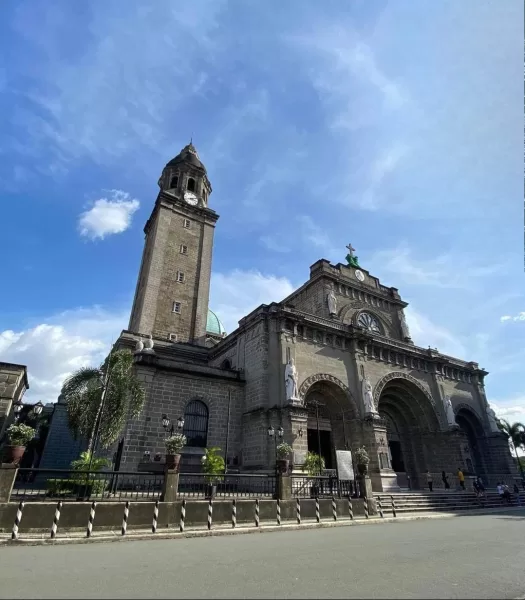
Just a short distance to the north from Intramuros, you’ll find the world’s oldest Chinatown of Binondo— a district established by Spaniards in 1594 for Chinese immigrants who converted to Catholicism. Today, the area is well-known for its restaurants and stalls that serve authentic dim sum and Chinese dishes. South of Intramuros, you’ll find the National Museum Complex and Rizal Park, honoring our national hero.
Today, Metro Manila extends beyond Manila City, comprising 16 cities and one municipality, each with its own vibe. Makati City and Bonifacio Global City are bustling financial and commercial centers, while Parañaque City and Pasay City host major transport hubs and resort casinos. Quezon City, the largest in terms of land area, houses the biggest universities, entertainment companies, and some government agencies.
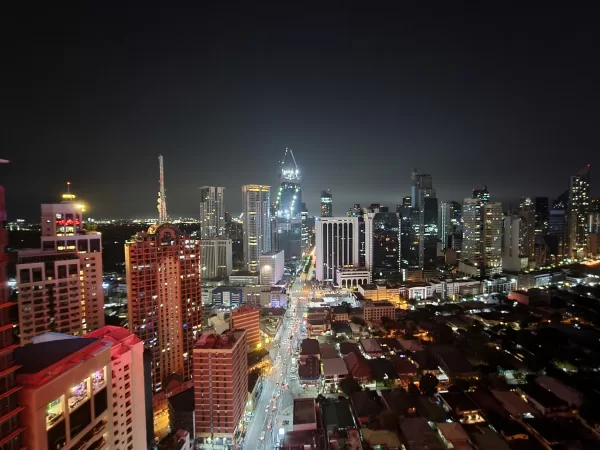
Sure! Getting around Metro Manila can be tough due to heavy traffic and a chaotic transportation system (Read: A Complete Guide to Public Transportation in Manila). However, it’s an eye-opening experience. You’ll see the diverse ways Filipinos live, from affluent areas to slums. but it offers a glimpse into how different Filipinos live. You’ll see the stark difference between rich and poor areas, like the fancy parts versus the slums.
To get to Metro Manila, you can fly into either Ninoy Aquino International Airport (NAIA) in Pasay City or Clark International Airport in Pampanga, about 80 kilometers north of Manila.
2. Cebu
The second largest metropolitan area in the Philippines is located in the island province of Cebu. Its capital, Cebu City, is also the oldest city in the country, famous for the Sinulog Festival— an annual festive celebration honoring the Child Jesus. With its historical significance as one of the earliest Spanish colonial settlements in the Philippines, Cebu has long been the central hub of commerce in the southern region.
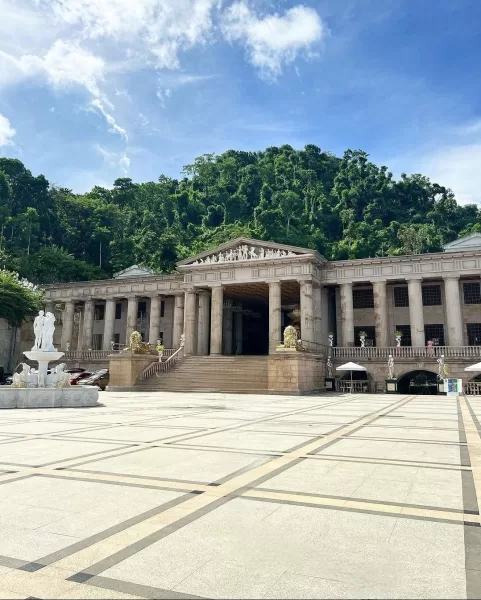
Throughout the province, you’ll find beautifully preserved centuries-old churches and structures. Among the must-see attractions are the Temple of Leah, Magellan’s Cross, 10,000 Roses, and Bantayan Island. For adventure seekers, Cebu offers activities like swimming with whale sharks in Oslob and canyoneering in Badian.
Whether you prefer city thrills or countryside calm, Cebu offers the best of both worlds. And getting there is a breeze, thanks to the Mactan–Cebu International Airport, the second busiest airport in the Philippines, located in Lapu-Lapu City.
3. Siargao Island
If you love adventure, Siargao Island is the place for you, located in the southeastern part of Surigao Del Norte province. Known as the “Surfing Capital of the Philippines,” it sits facing the Pacific Ocean and boasts top-notch surf spots, including the famous Cloud 9.
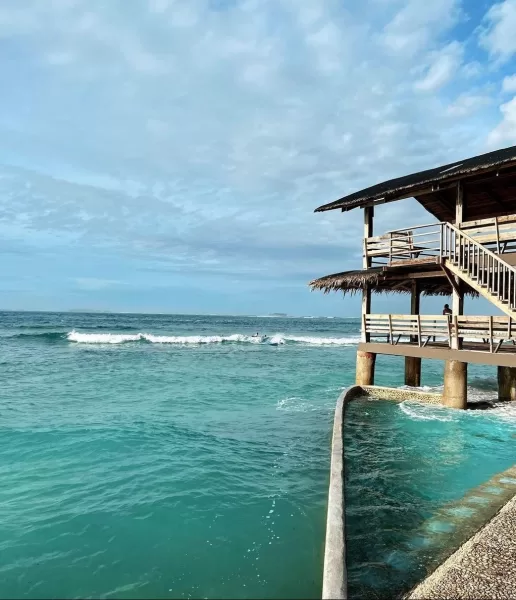
Besides surfing, there’s plenty to do, like rope swinging at Maasin River, wakeboarding at Siargao Wakepark, swimming at Magpupungko Rock Pools, and hitting the island’s various clubs. Hence, Siargao has become a hotspot for surfers, party animals, and beach lovers. The surge in tourism has led to concerns about the gentrification of Siargao. Many foreigners and Filipinos from urban areas are overextending their stay, or worse have decided to settle in Siargao, displacing locals and disrupting their livelihoods. Nevertheless, Siargao is a place worthy to visit. Siargao doesn’t have an international airport nearby, so the best way to reach it is by flying first to Manila or Cebu, then catching a connecting flight to Siargao.
4. Boracay Island
Boracay Island’s White Beach is arguably the most well-known among the many beaches in the Philippines. Its 4-kilometer stretch of powdery, white sand and clear waters has made it a favorite summer spot for locals and tourists alike. Over time, the island has grown into a bustling resort destination with hotels, restaurants, and bars dotted around. Visitors can enjoy various water activities like scuba diving, parasailing, jet skiing, and more.
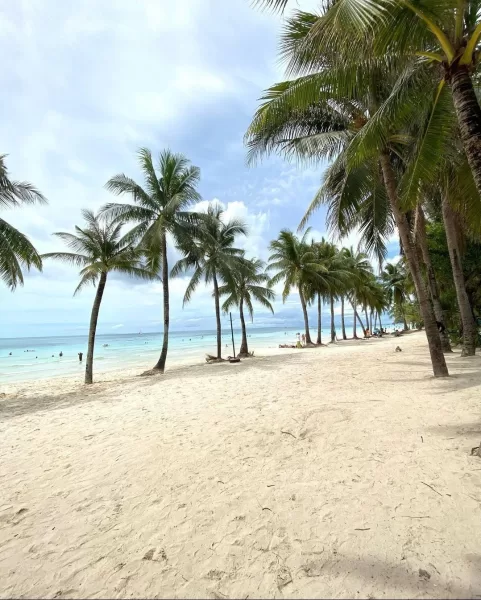
In addition to the White Beach, Boracay boasts other attractions including Bulabog Beach, Puka Beach, Crystal Cove, and Lugutan Magrove Park, among others. The island is also home to luxury resorts like Shangri-La, Discovery Shores, Movenpick, Crimson, and The Lind, most of which are situated on the northern part of the island.
The best way to get to Boracay is by flying to Caticlan airport and arranging a transfer service that includes a ferry from the Caticlan Jetty Port to Boracay, followed by a van ride to your hotel.
5. Palawan
If you’ve watched videos of the Philippines on TikTok, where you see clear waters surrounded by tall rock formations, chances are it’s Palawan. Palawan is a long, narrow archipelagic province boasting rocky coves and beautiful white sandy beaches. It’s the biggest province in the Philippines in terms of land area.
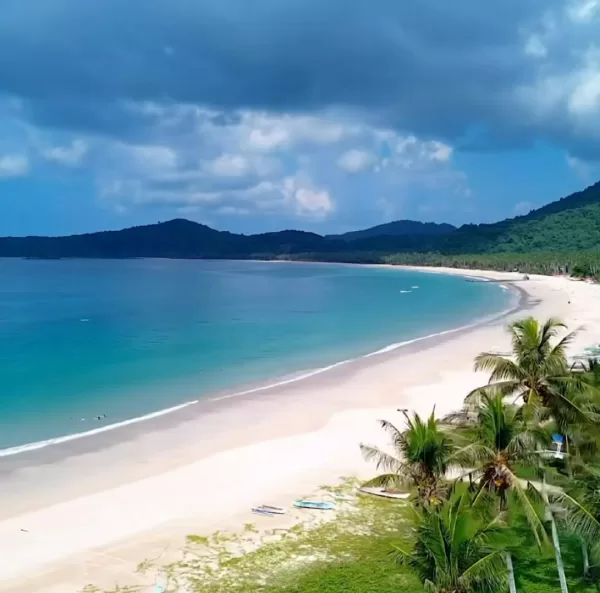
Three spots are particularly famous in Palawan: El Nido, Puerto Princesa, and Coron. Because Palawan is so big, moving from one town to another takes a while, so it’s smart to decide which towns you want to visit before you book your flight.
Puerto Princesa, the main city and entry point of the province, is known for attractions like the Underground River and Sabang Beach. El Nido and Coron are famous for their amazing lagoons surrounded by tall rock cliffs.
In El Nido, there are five standard tours to choose from, each showing you different places like beaches, lagoons, caves, sandbars, and waterfalls. El Nido is popular for its beaches, while Coron is known for its diving spots, especially wreck diving, where you can explore Japanese ships sunk during World War 2. El Nido is busier, but Coron is less crowded.
Balabac is another spot becoming more popular. It’s at the southern tip of Palawan and has about 30 islands and islets. It’s perfect for travelers who want to discover hidden gems. Although it’s a bit hard to get to, Balabac is home to some of the most beautiful untouched tropical places in the country.
Puerto Princesa, El Nido, and Coron all have their own airports, but flights to Puerto Princesa are usually cheaper than the other two.
6. Baguio City
Many tourists come to the Philippines for its sunny beaches and warm weather. However, there are also communities nestled in mountainous areas with unique cultures and cooler climates. One such place is Baguio City.
Situated in the northern part of the Philippines, in the mountainous Cordillera region, Baguio City sits 1.47 kilometers above sea level. The temperatures here can drop as low as 13 degrees Celsius, making it a popular destination for people from Manila seeking a chilly retreat, just a 4-hour drive from the capital.
Baguio’s cool climate has led to the proliferation of pine trees throughout the city, creating a picturesque setting unlike other urban areas in the Philippines. Additionally, Baguio is renowned for its Panagbenga Festival, held in February, which celebrates the diverse array of flowers found in the city.
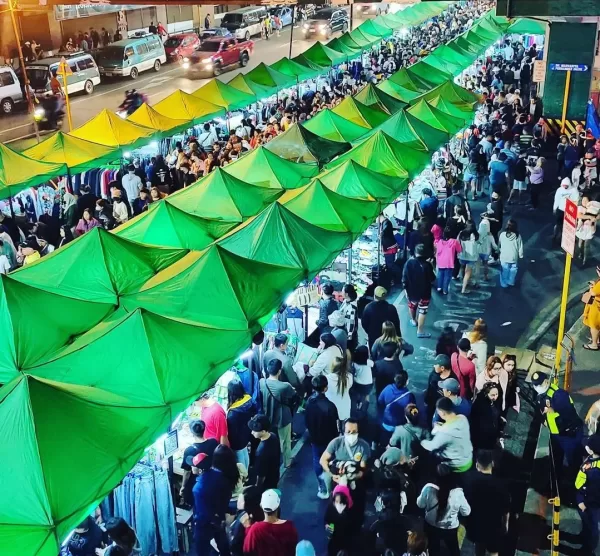
The influence of the Ibaloi tribe, reflected in Baguio’s textiles, cuisine, and customs, adds to the city’s charm. Tourist attractions in Baguio City include nature parks offering stunning views, cultural villages showcasing the traditions of the Ibaloi people, historic buildings dating back to the American and Japanese occupations, museums, scenic trails, and lively night markets.
Accommodation: Where to Stay
Accommodation options in the Philippines are generally quite affordable. While hostels are not as common, they can be found in touristy areas, with prices ranging from 300-1000 PHP (5-18 USD) per person per night. On popular islands like Siargao and Boracay, expect to pay more, especially during peak season. Many hostels offer amenities such as free Wi-Fi, complimentary breakfast, and air conditioning.
For more private options, cheap homestays can be found for as little as 600 PHP (11 USD) per night in cities and 400 PHP (7 USD) per night in the countryside. Budget hotels typically start at around 1,000 PHP (18 USD) per night, with various nationwide chains like RedDoorz, Hotel Sogo, and Eurotel available. Beachfront resorts in popular areas usually start at around 2,000 PHP (36 USD) per night, with luxury resorts exceeding 20,000 PHP (360 USD).
Additionally, Airbnb is a popular choice in the Philippines, offering numerous options in major cities starting at around 700 PHP (13 USD) per night.
Here’s our list of the best budget hotels in the Philippines:
- Hop Inn Hotel (Metro Manila and Cebu City)
- Red Planet Hotel (Metro Manila)
- Hotel 101 (Metro Manila)
- One Central Hotel & Suites (Cebu City)
- The Piccolo Hotel (Boracay)
- Savoy Hotel (Boracay)
- The Ohm Resort (Siargao)
- Bahandi Hotel (Siargao)
- The Ridge (Coron, Palawan)
- Hue Hotels and Resorts (Puerto Princesa, Palawan)
- South Anchorage Inn (El Nido, Palawan)
- G1 Lodge (Baguio)
Transportation: Getting Around the Philippines
Flights
The Philippines, being an archipelago, makes flights the most convenient mode of travel within the country. Depending on the airline, route, and booking date, flight prices can range from 1500 PHP (27 USD) to 15,000 PHP (268 USD).
Major airlines like Philippine Airlines, Cebu Pacific, and Air Asia operate nationwide, with Cebu Pacific and Air Asia generally offering more affordable options than Philippine Airlines. In addition to these, regional airlines like AirSwift and Sunlight Air serve select destinations. It’s important to note that flights to the islands are typically pricier than those between major cities.
Taxis
Taxis are readily available in major cities such as Metro Manila, Cebu, Davao, and Baguio. In Metro Manila, the flag-down rate for metered taxis is 45 PHP (0.8 USD) with an additional 2 PHP (0.036 USD) for every succeeding kilometer.
It is important to always opt for metered taxis to avoid being overcharged. If you observe that your driver is not using the meter, it is advisable to disembark and seek out a driver who will.
There are also specific airport taxis available, albeit at higher rates. Regular taxis are identifiable by their white color, while airport taxis are yellow.
Jeepneys
In the Philippines, jeepneys are a traditional public utility vehicle famous for their quirky decorations and open rear door design. They operate on fixed routes with specific end terminals but do not have designated stops. This means you can hop on or off a jeepney anywhere along its route, as long as the area is not marked as a no-boarding zone.
In Metro Manila, the fare for traditional jeepneys is 12 PHP (0.21 USD) for the first 4 kilometers, with an additional 1.80 PHP (0.032 USD) per succeeding kilometer. For modern jeepneys, the rate is a bit higher. In the provinces, jeepneys are also used for long-distance travel.
Buses
Buses are a common mode of transportation for both local travel within the metro and intercity journeys. In Metro Manila, the bus fare is 15 PHP (0.27 USD) for the first 5 kilometers, with an additional 2.65 PHP (0.047 USD) per succeeding kilometer.
Intercity bus prices vary based on the amenities offered, such as sleeper buses and lazy-boy seats, which come at a higher cost. For example, a standard air-conditioned bus ticket from Manila to Baguio costs around 600 PHP (12 USD), while a lazy-boy bus ticket is around 1000 PHP (20 USD).
Ride-Hailing Applications
Mobile-based ride-hailing applications connect passengers with drivers for on-demand transportation services. In major cities, four such platforms are currently operating: Grab, Angkas, Joyride, and Move It. Grab provides both GrabCar (a car-hailing service) and GrabTaxi (a taxi-hailing service), while Angkas, Joyride, and MoveIt offer motorcycle-hailing services.
Although Grab is generally more expensive than regular taxis, it offers the convenience of cashless transactions and helps passengers avoid potential overcharging by taxi drivers. On the other hand, motorcycle-hailing services are notably cheaper and often faster due to their ability to navigate through unpredictable traffic with ease.
Trains
In the Philippines, only Metro Manila and nearby provinces are connected by train. While these train systems tend to be slow, they offer a scenic option for navigating the metro. Currently, five railway systems are operating in Metro Manila: LRT-1, LRT-2, MRT-3, PNR South Commuter, and PNR North Commuter lines. None of these lines operate 24 hours; typically, trains run from 4:30 AM to 10 PM.
Must-Try Filipino Foods
While in the Philippines, don’t miss the opportunity to explore Filipino cuisine. Like many Asian nations, rice is a dietary staple throughout the country, accompanying most Filipino dishes. However, due to its diverse archipelagic geography, Filipino cuisine offers a wide range of flavors influenced by factors such as regional ingredients, culinary preferences, and cultural traditions.
Each ethnolinguistic group boasts its unique array of dishes, often with variations even on popular favorites. For instance, longganisa, a ground pork sausage, is typically sweet in Cebu but garlicky in Quezon Province. Bicolanos and Maguindanaons favor spicy cuisine, while Ilocanos are known for their penchant for bitter flavors like papaitan.
While some dishes may not suit everyone’s taste, there’s bound to be something that appeals to you. Filipino cuisine also bears significant Spanish and Chinese influences, adding further depth to its culinary landscape. Given the vast array of dishes, fully exploring Filipino cuisine in a single visit is a daunting task, but sampling some during your time here is a must.
Keep in mind that, except for noodle dishes, desserts, and street food, most Filipino dishes are traditionally enjoyed with rice to balance flavors. Attempting to consume them alone may result in overpowering tastes.
Below is a list of notable Filipino dishes you should consider trying during your stay:
Main Dishes
Pair these with rice:
- Adobo – We prefer the Kapampangan variation called Adobong Puti, which is chicken or pork marinated in vinegar, salt, fish sauce, garlic, pepper, and bay leaves.
- Sinigang – Any meat or seafood cooked in a sour soup. The souring ingredient can be any sour fruit such as tamarind, batwan, or kamias.
- Kare-Kare – A stew made with oxtail, tripe, and vegetables, simmered in a thick, savory peanut sauce and often served with shrimp paste on the side.
- Lumpiang Shanghai – Consists of small, crispy-fried spring rolls filled with a mixture of ground pork, onions, carrots, and seasonings.
- Sisig – Typically made with chopped pig’s face and ears, served on a sizzling hot plate, often mixed with onions, chili peppers, and citrus juice.
Noodle Dishes
- Pansit Bihon – Made with thin rice noodles stir-fried with vegetables and meat, and often seasoned with soy sauce and citrus juice.
- Sotanghon – Consists of glass noodles made from mung bean starch, typically cooked in a flavorful broth with meat, seafood, and vegetables.
- Lomi Batangas – A noodle soup originating from the Batangas region, characterized by its thick egg noodles and rich broth made from pork or chicken, topped with pork meat, liver, shrimp, cabbage, and boiled egg.
- Palabok – Rice noodles topped with a flavorful orange-colored sauce made from shrimp, ground pork, and annatto seeds, garnished with hard-boiled eggs, crushed pork cracklings, green onions, and Philippine lime.
- Pancit Canton – Chinese-Filipino stir-fried noodles, typically made with wheat flour noodles, mixed with vegetables, meat, and savory seasonings.
Street Food
- Kwek-Kwek – Deep-fried quail eggs coated in an orange-colored batter, best paired with a sweet and spicy dip.
- Siopao – Steamed bun typically filled with savory ingredients such as seasoned pork, chicken, or beef.
- Balut – A fertilized duck embryo that is boiled and eaten from the shell. Don’t forget to drink the soup inside the egg first.
- Taho – A morning snack made of fresh soft tofu, sweet syrup, and tapioca pearls.
- Turon – A dessert made of sliced bananas and jackfruit rolled in brown sugar and wrapped in a spring roll wrapper before being fried until crispy.
Best Things to Buy in the Philippines
Whether for yourself or your loved ones back home, here are the best things to buy in the Philippines:
- Filipino snacks – Every province boasts its specialty snacks, perfect for bringing back home. Among the most renowned are dried mangoes and otap from Cebu, pili nuts from Bicol, ube jam from Baguio, buko pie from Laguna, and peanut kisses from Bohol.
- Catholic religious items – The Philippines is a largely Catholic country, hence, you can easily find religious items in local shops near churches including rosaries, bibles, and religious statues.
- Shell accessories – You can find locals selling shell necklaces and bracelets on touristy beaches like Boracay, La Union, Puerto Galera, and Siargao.
- Coconut products – The Philippines has an abundant supply of coconut trees so coconut products like virgin coconut oil, coconut juice, broomstick, and wooden barbecue sticks are cheaper here than in other countries.
- Mangoes – The Philippines has some of the sweetest mangoes, specifically the Guimaras mangoes and the Sweet Elena variety from Zamboanga.
- Handwoven baskets – Handwoven baskets made from natural fibers like bamboo, rattan, and nipa are common in the Philippines, particularly in the province of Sorsogon.
When to Visit the Philippines
To avoid the rainy season, visit the Philippines from December to May. December is vibrant with Christmas celebrations, but rain and storms can still occur.
If heading to Boracay, be aware of green algae during the dry season; it’s best to go between November and early February.
Travel Tips and Reminders
- Wear sunscreen. Due to its proximity to the equator, the Philippines experiences intense sunlight which can be harmful, especially for individuals with lighter skin tones.
- Learn basic Filipino phrases. “Salamat” translates to “Thank you.” Contrary to popular belief among foreigners, “Mabuhay” isn’t typically used as a greeting in everyday conversations. Simply saying “hi” will do. And if you’re on a jeepney and need to get off, just say “Para po!”
- Mind your belongings. Watch out for petty theft, like bag snatching, in crowded areas. Be sure to keep an eye on your belongings, especially when using public transportation.
- In case of emergency, dial 911 for the Philippine National Police or 8888 for the public complaint hotline.
- Cannabis and other dangerous drugs are prohibited in the Philippines.
Ron Lao is an engineering graduate with a passion for writing informative content and exploring new places, cultures, and food. He loves science, cats, badminton, and anything wellness-related.


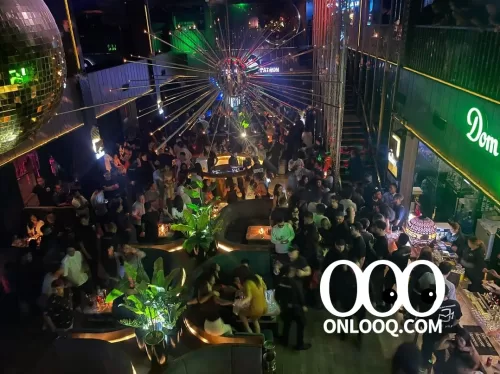
Leave a Reply